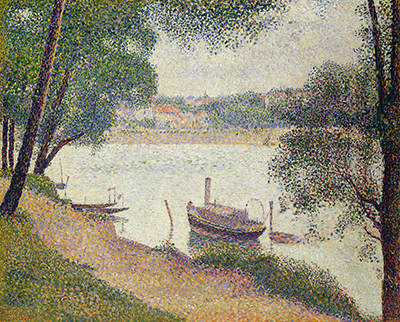Sometimes artists are connected by period – being simultaneous discoverers of new ways of making art, for example, other are connected by themes – biblical themes, the ancient Greek and Roman myths, or that most fickle master, love. Still others are connected by place, with artists throning to places where are can be created, where ideals are more easily overlaid on real world landscapes that come close the vision in one's head. One such place is the small island of la Grand Jatte, which translates, rather unflatteringly into 'the big bowl', which has been commemorated by many artists, especially around the end of the nineteenth century and the beginning of the twentieth.
These include Claude Monet and Vincent Van Gogh, as well as Alfred Sisley, Pierre Bonnard and Emile Bernard – and the young master of pointillism, Georges Seurat, whose most famous paintings capture moments of leisure for working class people in the beautiful surroundings of the park in which the island can be found. Seurat (and doubtless many of his contemporaries too) returned often to the island, finding new vantage points, spotting moments of perfect idleness on the part of people who normally had to fight and scrabble to survive. Occasionally, however, the weather would turn, and Seurat would find his preferred landscape denuded of the people who enjoyed sunny days outside, but stayed firmly inside during inclement weather.
This image captures one of those days, and the slightly unimaginative name works well with the painting: Gray Weather, Grande Jatte, tells the anticipatory viewer all they need to know about this painting before they see it! The image is of a place at rest, abandoned for now, but certainly not forever, as can be ascertained by the canoes pulled into the riverbank, and the small well-kept boat, tied to its mooring post for the duration. Through the trees that dot the bank where the artist is standing, the distant red roofs of Paris can be seen, allowing the viewer to infer that the island is deserted during today's poor weather in favour of the indoor delights of Paris – but the air of anticipation and waiting is beautifully rendered, to the point where a viewer might even be tempted to wait, just in case a hardy soul comes strolling by, determined to enjoy their regular constitutiona l, never mind the chilly, grey day.
The painting, in oil on canvas, and measuring 28 inches by 34 inches, can be found in the Metropolitan Museum of Art – where it will stay for the foreseeable future, as under the terms of its acquisition the piece cannot be loaned out.




